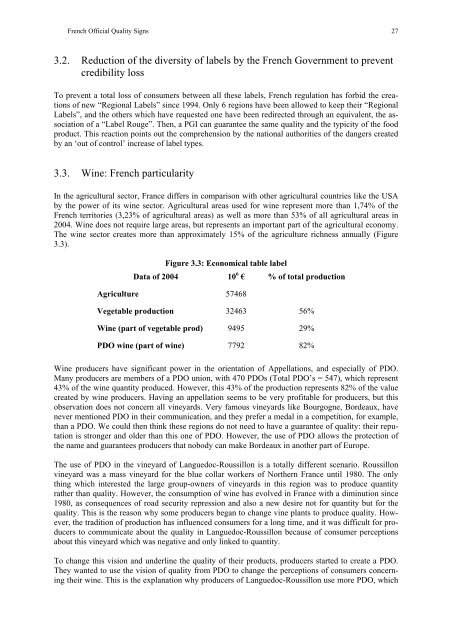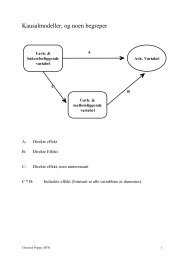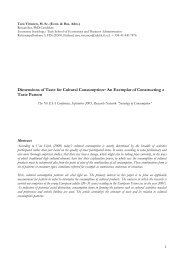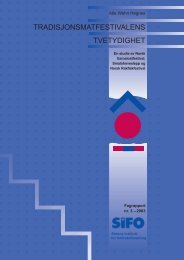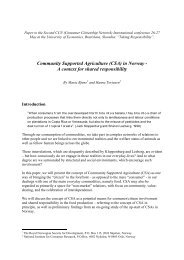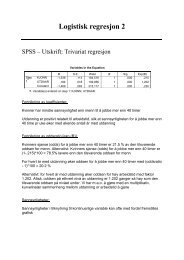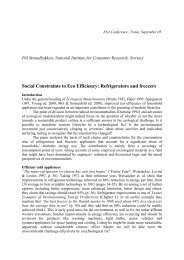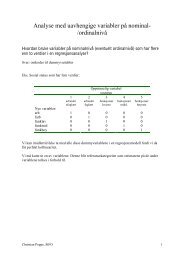Rapport nr - SIFO
Rapport nr - SIFO
Rapport nr - SIFO
- No tags were found...
You also want an ePaper? Increase the reach of your titles
YUMPU automatically turns print PDFs into web optimized ePapers that Google loves.
French Official Quality Signs 273.2. Reduction of the diversity of labels by the French Government to preventcredibility lossTo prevent a total loss of consumers between all these labels, French regulation has forbid the creationsof new “Regional Labels” since 1994. Only 6 regions have been allowed to keep their “RegionalLabels”, and the others which have requested one have been redirected through an equivalent, the associationof a “Label Rouge”. Then, a PGI can guarantee the same quality and the typicity of the foodproduct. This reaction points out the comprehension by the national authorities of the dangers createdby an ‘out of control’ increase of label types.3.3. Wine: French particularityIn the agricultural sector, France differs in comparison with other agricultural countries like the USAby the power of its wine sector. Agricultural areas used for wine represent more than 1,74% of theFrench territories (3,23% of agricultural areas) as well as more than 53% of all agricultural areas in2004. Wine does not require large areas, but represents an important part of the agricultural economy.The wine sector creates more than approximately 15% of the agriculture richness annually (Figure3.3).Figure 3.3: Economical table labelData of 2004 10 6 € % of total productionAgriculture 57468Vegetable production 32463 56%Wine (part of vegetable prod) 9495 29%PDO wine (part of wine) 7792 82%Wine producers have significant power in the orientation of Appellations, and especially of PDO.Many producers are members of a PDO union, with 470 PDOs (Total PDO’s = 547), which represent43% of the wine quantity produced. However, this 43% of the production represents 82% of the valuecreated by wine producers. Having an appellation seems to be very profitable for producers, but thisobservation does not concern all vineyards. Very famous vineyards like Bourgogne, Bordeaux, havenever mentioned PDO in their communication, and they prefer a medal in a competition, for example,than a PDO. We could then think these regions do not need to have a guarantee of quality: their reputationis stronger and older than this one of PDO. However, the use of PDO allows the protection ofthe name and guarantees producers that nobody can make Bordeaux in another part of Europe.The use of PDO in the vineyard of Languedoc-Roussillon is a totally different scenario. Roussillonvineyard was a mass vineyard for the blue collar workers of Northern France until 1980. The onlything which interested the large group-owners of vineyards in this region was to produce quantityrather than quality. However, the consumption of wine has evolved in France with a diminution since1980, as consequences of road security repression and also a new desire not for quantity but for thequality. This is the reason why some producers began to change vine plants to produce quality. However,the tradition of production has influenced consumers for a long time, and it was difficult for producersto communicate about the quality in Languedoc-Roussillon because of consumer perceptionsabout this vineyard which was negative and only linked to quantity.To change this vision and underline the quality of their products, producers started to create a PDO.They wanted to use the vision of quality from PDO to change the perceptions of consumers concerningtheir wine. This is the explanation why producers of Languedoc-Roussillon use more PDO, which


